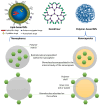Organic Nanoparticles in Progressing Cardiovascular Disease Treatment and Diagnosis
- PMID: 38794614
- PMCID: PMC11125450
- DOI: 10.3390/polym16101421
Organic Nanoparticles in Progressing Cardiovascular Disease Treatment and Diagnosis
Abstract
Cardiovascular diseases (CVDs), the world's most prominent cause of mortality, continue to be challenging conditions for patients, physicians, and researchers alike. CVDs comprise a wide range of illnesses affecting the heart, blood vessels, and the blood that flows through and between them. Advances in nanomedicine, a discipline focused on improving patient outcomes through revolutionary treatments, imaging agents, and ex vivo diagnostics, have created enthusiasm for overcoming limitations in CVDs' therapeutic and diagnostic landscapes. Nanomedicine can be involved in clinical purposes for CVD through the augmentation of cardiac or heart-related biomaterials, which can be functionally, mechanically, immunologically, and electrically improved by incorporating nanomaterials; vasculature applications, which involve systemically injected nanotherapeutics and imaging nanodiagnostics, nano-enabled biomaterials, or tissue-nanoengineered solutions; and enhancement of sensitivity and/or specificity of ex vivo diagnostic devices for patient samples. Therefore, this review discusses the latest studies based on applying organic nanoparticles in cardiovascular illness, including drug-conjugated polymers, lipid nanoparticles, and micelles. Following the revised information, it can be concluded that organic nanoparticles may be the most appropriate type of treatment for cardiovascular diseases due to their biocompatibility and capacity to integrate various drugs.
Keywords: cardiovascular diseases; dendrimers; liposomes; micelles; nanomedicine; organic nanoparticles; polymeric nanoparticles.
Conflict of interest statement
The authors declare no conflicts of interest.
Figures


Similar articles
-
Nanomedicines for cardiovascular disease.Nat Cardiovasc Res. 2023 Apr;2(4):351-367. doi: 10.1038/s44161-023-00232-y. Epub 2023 Apr 3. Nat Cardiovasc Res. 2023. PMID: 39195953 Review.
-
Recent Advances in the Development of Theranostic Nanoparticles for Cardiovascular Diseases.Nanotheranostics. 2021 Jul 21;5(4):499-514. doi: 10.7150/ntno.62730. eCollection 2021. Nanotheranostics. 2021. PMID: 34367883 Free PMC article. Review.
-
The Clinical Translation of Organic Nanomaterials for Cancer Therapy: A Focus on Polymeric Nanoparticles, Micelles, Liposomes and Exosomes.Curr Med Chem. 2018;25(34):4224-4268. doi: 10.2174/0929867324666170830113755. Curr Med Chem. 2018. PMID: 28875844 Review.
-
Nanotherapeutics: An insight into healthcare and multi-dimensional applications in medical sector of the modern world.Biomed Pharmacother. 2018 Jan;97:1521-1537. doi: 10.1016/j.biopha.2017.11.026. Epub 2017 Nov 21. Biomed Pharmacother. 2018. PMID: 29793315 Review.
-
Advances in nanobased platforms for cardiovascular diseases: Early diagnosis, imaging, treatment, and tissue engineering.Environ Res. 2023 Dec 1;238(Pt 1):116933. doi: 10.1016/j.envres.2023.116933. Epub 2023 Aug 29. Environ Res. 2023. PMID: 37652218 Review.
References
-
- Chen Y., Freedman N.D., Albert P.S., Huxley R.R., Shiels M.S., Withrow D.R., Spillane S., Powell-Wiley T.M., Berrington de González A. Association of Cardiovascular Disease With Premature Mortality in the United States. JAMA Cardiol. 2019;4:1230–1238. doi: 10.1001/jamacardio.2019.3891. - DOI - PMC - PubMed
-
- Khan M.A.B., Hashim M.J., Mustafa H., Baniyas M.Y., Al Suwaidi S.K.B.M., AlKatheeri R., Alblooshi F.M.K., Almatrooshi M.E.A.H., Alzaabi M.E.H., Al Darmaki R.S. Global epidemiology of ischemic heart disease: Results from the global burden of disease study. Cureus. 2020;12:e9349. doi: 10.7759/cureus.9349. - DOI - PMC - PubMed
-
- Zhang L., Li Q., Han X., Wang S., Li P., Ding Y., Zhang T., Zhao J., Chen Y., Liu J., et al. Associations of socioeconomic factors with cause-specific Mortality and burden of cardiovascular diseases: Findings from the vital registration in urban Shanghai, China, during 1974–2015. BMC Public Health. 2020;20:1291. doi: 10.1186/s12889-020-09390-1. - DOI - PMC - PubMed
Publication types
LinkOut - more resources
Full Text Sources

